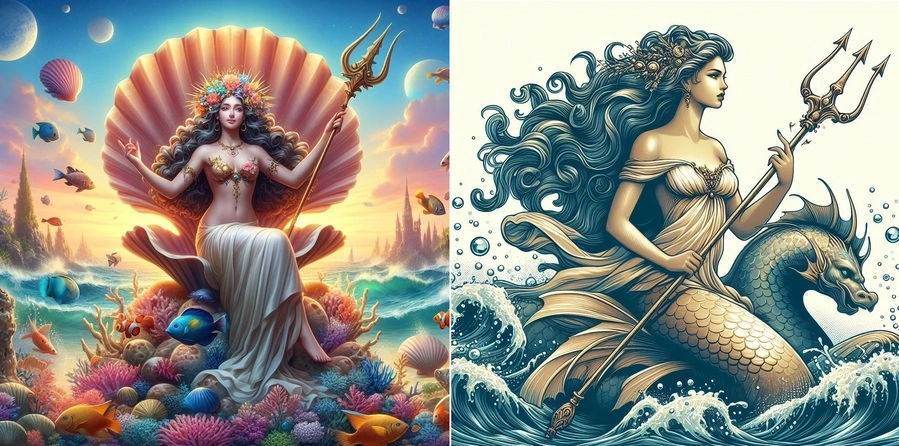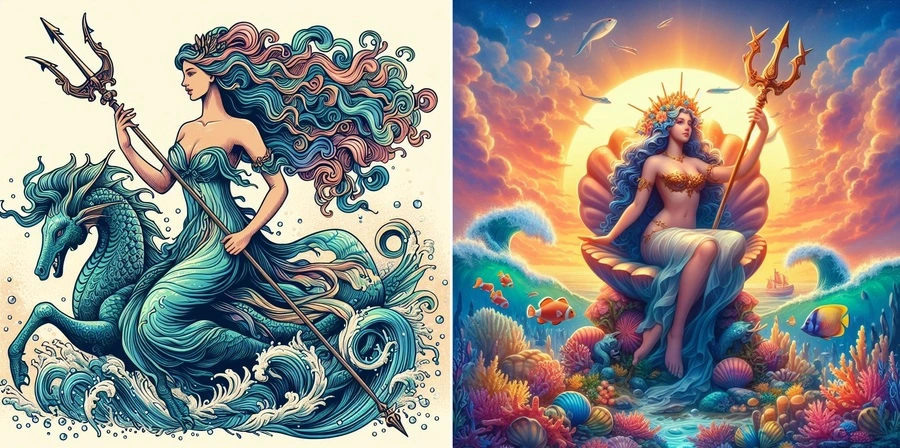
In Greek mythology, Amphitrite was the goddess of the sea, wife of Poseidon, and one of the Nereids, the fifty daughters of the sea god Nereus and the Oceanid Doris. She was often depicted as a beautiful woman with long, flowing hair, holding a trident and riding on a sea creature. Amphitrite was a powerful figure in Greek mythology, and her story is filled with myths and legends that have been passed down through the ages.
The Story of Amphitrite
According to one myth, Amphitrite was initially resistant to the advances of Poseidon, who was known for his lustful ways. However, he was persistent in his pursuit of her and eventually won her over with a golden chariot pulled by seahorses. They were married in a lavish ceremony attended by many of the gods and goddesses, and Amphitrite became the queen of the sea.
As the goddess of the sea, Amphitrite was responsible for controlling the tides and the waves. She was often depicted riding on a sea creature, such as a dolphin or a sea serpent, and was believed to have the power to calm the waters or stir up violent storms depending on her mood. She was also a protector of sailors and fishermen, and it was believed that she could grant safe passage to those who prayed to her.
Amphitrite had several children with Poseidon, including a son named Triton, who was depicted as a merman with the upper body of a human and the tail of a fish. Triton was a powerful figure in his own right, and was responsible for controlling the sea waves and guiding ships through treacherous waters.
10 Myths and Facts About Amphitrite
- Myth 1: Amphitrite was the most beautiful of the Nereids. Fact: While Amphitrite was undoubtedly beautiful, she was not necessarily considered the most beautiful of the Nereids. The Nereids were a group of fifty sea nymphs, all of whom were said to be breathtakingly beautiful.
- Myth 2: Amphitrite was initially resistant to Poseidon’s advances. Fact: This is true. According to one myth, Amphitrite was initially resistant to Poseidon’s advances and fled to the Atlas Mountains in North Africa to avoid him. However, he eventually won her over and they were married in a lavish ceremony.
- Myth 3: Amphitrite had the power to control the sea. Fact: This is true. As the goddess of the sea, Amphitrite had the power to control the tides and the waves, and could calm the waters or stir up violent storms depending on her mood.
- Myth 4: Amphitrite had several children with Poseidon. Fact: This is true. Amphitrite had several children with Poseidon, including a son named Triton, who was a powerful figure in his own right.
- Myth 5: Amphitrite was associated with the element of water. Fact: This is true. As the goddess of the sea, Amphitrite was strongly associated with the element of water, and was often depicted riding on a sea creature or holding a trident.
- Myth 6: Amphitrite was worshipped in ancient Greece. Fact: This is true. Amphitrite was a popular goddess in ancient Greece and was worshipped in various places throughout the region. Temples and sanctuaries were dedicated to her, and she was often honored in various religious festivals and rituals.
- Myth 7: Amphitrite was a symbol of fertility and abundance. Fact: This is true. Amphitrite was often associated with the cycles of life and death, and was seen as a symbol of fertility and abundance. She was often depicted holding a cornucopia or a vase, representing her ability to bring prosperity and abundance to the land.
- Myth 8: Amphitrite was also associated with other aspects of nature. Fact: This is true. In addition to her association with the sea and fertility, Amphitrite was also connected to other aspects of nature, such as the changing of the seasons and the cycles of the moon.
- Myth 9: Amphitrite was often depicted as a gentle and nurturing goddess. Fact: This is true. While she could be powerful and fierce when needed, Amphitrite was often depicted as a gentle and nurturing goddess who cared for her children and protected the sea and its inhabitants.
- Myth 10: Amphitrite was often associated with dolphins. Fact: This is true. Amphitrite was often associated with dolphins, which were believed to be sacred to her. In some myths, she was said to ride on the back of a dolphin or to have the ability to transform into a dolphin herself.
The Symbols of Amphitrite
One of the most common symbols associated with Amphitrite is the trident, which was often used to represent her connection to the sea and her power to control the tides and the waves. The trident was also a symbol of Poseidon, and it was often depicted as a powerful and fearsome weapon that could cause destruction and chaos.

Another symbol commonly associated with Amphitrite is the sea creatures that were said to surround her. She was often depicted riding on the back of a sea creature, such as a dolphin or a sea serpent, which symbolized her connection to the natural world and her ability to control the movements of the sea. These sea creatures were also seen as symbols of good luck and protection, and sailors would often pray to Amphitrite for safe passage during their journeys.
The image of a conch shell is another symbol associated with Amphitrite in Greek mythology. The conch shell was often used to represent the sound of the sea, and it was believed that the shell could be used to communicate with Amphitrite and other sea gods and goddesses. It was also seen as a symbol of beauty and femininity, and many depictions of Amphitrite show her holding or surrounded by conch shells.
Finally, the image of a crown or a wreath is another symbol commonly associated with Amphitrite. These crowns and wreaths were often made up of shells or sea creatures, and were used to represent her status as the queen of the sea. They were also seen as symbols of power and authority, and were often worn by other powerful goddesses in Greek mythology.
Amphitrite in Mythological Narratives
While Amphitrite’s appearances in mythological tales are less frequent than those of other deities, her presence is nonetheless significant. In one notable myth, she is involved in the story of Theseus, the hero who ventured into the labyrinth to slay the Minotaur. After his victory, Theseus throws himself into the sea, and Amphitrite welcomes him to her underwater palace. She gifts him a crown that becomes the constellation Corona Australis, highlighting her role as a benevolent and protective goddess.
Another intriguing tale involves the god Apollo, who fell in love with a mortal princess named Coronis. Jealous of his affection for another, Amphitrite sent a dolphin to abduct Coronis, bringing her to the sea goddess’s realm. This story underscores Amphitrite’s dominion over the sea and its creatures, as well as her capacity for both compassion and retribution.
Frequently Asked Questions
Where Does Amphitrite Live
Amphitrite, the goddess of the sea in Greek mythology, resides in the depths of the ocean. She lives in a magnificent underwater palace alongside her husband, Poseidon, the god of the sea. This palace is often depicted as a splendid and grand abode, filled with marine creatures and adorned with treasures of the deep, symbolizing her dominion over the ocean and its vast, mysterious realms.
What Are Amphitrite Powers
In Greek mythology, Amphitrite’s powers centered around her dominion as the goddess of the sea:
- Command of the Seas: Amphitrite wielded immense power over the ocean itself. She could control the waves, stir up storms, and calm raging waters.
- Sea Life Communication: As queen of the seas, she possessed the ability to communicate with and command all creatures dwelling within the ocean depths.
- Underwater Realm: Amphitrite held dominion over the underwater world. Her presence could influence the growth of coral reefs, the movement of currents, and the hidden treasures within the sea.
Why Did Poseidon Marry Amphitrite
Poseidon married Amphitrite because he was captivated by her beauty and grace. Initially, Amphitrite fled to avoid Poseidon’s advances, but he was determined to win her over. Poseidon sent his loyal dolphin, Delphinus, to find her and persuade her to return. Delphinus succeeded, and Amphitrite agreed to marry Poseidon. In gratitude, Poseidon placed Delphinus among the stars as the constellation Delphinus. Their marriage symbolized the union of the powerful and tempestuous aspects of the sea (Poseidon) with its tranquil and nurturing qualities (Amphitrite).